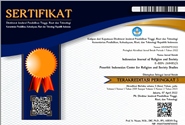The Plaho Ritual: Cultural Study on Siulak Community, Kerinci Regency
Abstract
The Plaho ritual is a tradition tribute to the spirits of ancestors who have died long ago by providing food offerings such as white rice, yellow rice, black rice, brown rice, chicken eggs, duck eggs, roasted sticky rice called lemang, roasted chicken, orange juice, various flowers, betel leaves and etc. This ritual is carried out when people in the community suffer from misfortune, illness, have no offspring or no sustenance, or when they want to make a pledge in order to avoid misfortune, have success in trading, produced a lot of agricultural products, and so on. This ethnographic research was using an interpretive theoretical analysis proposed by Clifford Geertz and was conducted in the Siulak community, Kerinci Regency. Informant selection technique was carried out by using a deliberate selection of informant namely purposive sampling technique. Data collected through observation and in-depth interviews were then analyzed using interpretive analysis with steps as follows: data hermeneutic, data interpretation, and interpretative representation. This research results reveals that the Plaho ritual is still carried out by Siulak community since they believe that by carrying out this ritual, they will be protected from all disasters and dangers threatening their social life and that not all diseases can be treated medically. Plaho ritual to Siulak community also has a separate function which indirectly is a form of respect for their ancestors, as a cultural inheritance, as a form of retreat, a reminder of death, and a means of social integration, which purpose is none other than to get oneself closer to The Almighty God.
Keywords
Full Text:
PDFReferences
Alimin. (2006). Customs and Culture of the Kerinci Region . Kerinci Regency Cultural Office.
Ferdianto, F., & Setiyani, S. (2018). Pengembangan Bahan Ajar Media Pembelajaran Berbasis Kearifan Lokal Mahasiswa Pendidikan Matematika. JNPM (Jurnal Nasional Pendidikan Matematika), 2(1), 37. https://doi.org/10.33603/jnpm.v2i1.781
Geertz, C. (1977). The Interpretation Of Cultures (Basic Books Classics). Basic Books, Inc., Puhlishers.
Geertz, C. (1992). Tafsir Kebudayaan. Yogyakarta: Kanisius.
Kaplan, D. (1999). Teori Budaya (terjemahan),. Pustaka Pelajar , 2002.
Keesing, R. M. (2014). Teori-Teori Tentang Budaya. Antropologi, 52, 3–32. https://doi.org/10.7454/ai.v0i52.3313
Koentjaraningrat. (1972). Beberapa Pokok Antropologi Sosial.
Muzadi, M. M., Sudarto, S., Alim, M. F., & Setiono, M. A. (2021). Eksistensi Tradisi Syawalan di Desa Bungo, Kecamatan Wedung, Kabupaten Demak. Anthropos: Jurnal Antropologi Sosial Dan Budaya (Journal of Social and Cultural Anthropology), 7(1), 106. https://doi.org/10.24114/antro.v7i1.24737
Purba, M., & Pasaribu, B. M. (2006). Musik Populer: Buku Pelajaran Kesenian Nusantara. Jakarta: Lembaga Pendidikan Seni Nusantara.
Ramadani, Y. (2020). Ritual Tarei Asyeik Pada Masyarakat Kelurahan Pondok Tinggi Kota Sungai Penuh (Kerinci) Provinsi Jambi. Universitas Negeri Padang.
Ramadani, Y., & Qommaneeci, A. (2018). Pengaruh Pelaksanaan Kenduri Sko (Pesta Panen) Terhadap Perekonomian Dan Kepercayaan Masyarakat Masyarakat Kerinci, Provinsi Jambi. Jurnal Antropologi: Isu-Isu Sosial Budaya, 20(1), 71. https://doi.org/10.25077/jantro.v20.n1.p71-83.2018
Ramadani, Y., & Qommaneeci, A. (2020). Tradisi Wisuda Secara Adat di Masyarakat Lekuk 50 Tumbi Lempur, Kabupaten Kerinci, Jambi. Jurnal Antropologi: Isu-Isu Sosial Budaya, 22(1), 29. https://doi.org/10.25077/jantro.v22.n1.p29-37.2020
Rietjens, S. (2015). Qualitative Data-Analysis: Seeing the Patterns in The Fog of Civil-Military Interaction. In Routledge Handbook of Research Methods in Military Studies. London: Routledge. https://doi.org/10.4324/9780203093801.ch12
Saifuddin, A. F. (2005). Antropologi Kontemporer: Suatu Pengantar Kritis Mengenai Paradigma. Jakarta: Kencana.
DOI: https://doi.org/10.36256/ijrs.v4i2.302
Refbacks
- There are currently no refbacks.
Copyright (c) 2022 Indonesian Journal of Religion and Society

This work is licensed under a Creative Commons Attribution-NonCommercial 4.0 International License.
Indonesian Journal of Religion and Society (IJRS) Is Indexed By:

Indonesian Journal of Religion and Society (IJRS) is distribute under Creative Commons Attribution-NonCommercial 4.0 International License.













